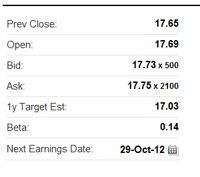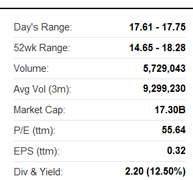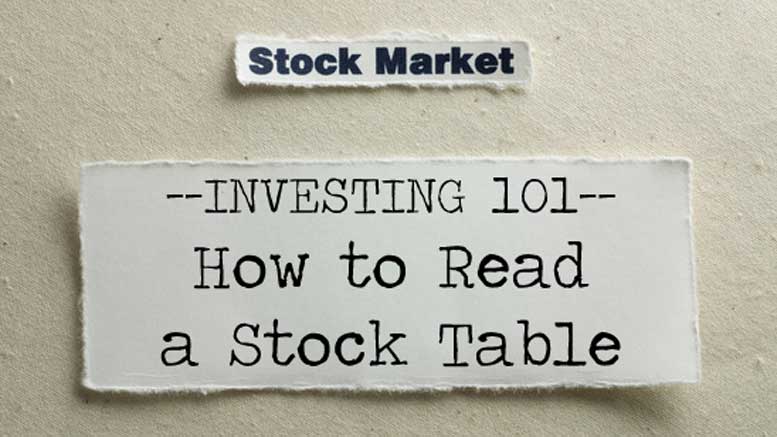Bid… Ask… P/E Ratio?
The stock market is filled with intricate words and acronyms that can intimidate the novice investor. In this brief article, you will learn some of the basic financial terms and concepts that will appear when reading a basic stock table.

Above is a sample stock table taken from Yahoo! Finance.
At the top of the table you will see the name of the stock (Annaly Capital Management, Inc.) followed by its ticker symbol in parentheses (NLY). This ticker symbol is unique to this company and is typically assigned to it by the stock exchange on which it is traded.
Following the ticker symbol, you will see the acronym, NYSE. This refers to the particular stock exchange that this company’s stock is traded on. In this case, NLY is traded on the NYSE, or the New York Stock Exchange.

Below the company’s name and ticker symbol you will see the current price along with the current gains or losses on the stock during the latest trading session.
Next, let’s examine the left column of data.

Prev. Close: This is the closing price of the stock during the last trading session, which usually refers to yesterday.
Open: This refers to the stock’s open price, or the price at which the stock opened during the current trading session.
Bid: The offering price at which current would-be buyers are willing to pay for the stock. This is also the price that current sellers are likely to receive if they sell immediately at the market.
Ask: The price at which current stockholders are willing to sell their shares of stock. This is also the price that current buyers are likely to pay if they were to purchase shares at current market prices.
1y Target Est: This data field is uncommon when looking at some stock tables. However, on Yahoo! Finance, this refers to the median target price forecast by analysts covering the stock. I tend to ignore this data on Yahoo as it is not updated regularly and is rarely correct.
Beta: Beta is a historical measurement of the volatility of a stock as compared to the stock market as a whole. So if the numerical value of a stock’s beta is 1 then its volatility is equal to that of the overall stock market. The higher this number, the more volatility the investor should expect. A lower beta number, however, implies that the stock is less volatile than the overall stock market.

Learn more about Jerry Robinson’s Daily Trade SetupsNext Earnings Date: Companies typically report their earnings four times per year, or every quarter. This data field simply refers to the next earnings reporting date for this company.
Let’s now consider the data in the right column.
 Day’s Range: This refers to the highest and lowest price that the stock has reached during the current (or last, if the markets are closed) trading session.
Day’s Range: This refers to the highest and lowest price that the stock has reached during the current (or last, if the markets are closed) trading session.
52 Week Range: Here you will find the highest and lowest price that the stock has reached over the last 52 week time period. This range helps you understand if the stock’s current price is closer to its high or low for the last 12 months.
Volume: The number of shares of this particular stock that were traded in the market during the current (or last, if the markets are closed) trading session. I tend to avoid trading stocks that have extremely low volume. Why? Because getting in and out of thinly traded, low volume stocks can be difficult. Beware.
Average Volume (3 months): The average volume of the stock over the last 3 months. This number is helpful to determine if the trading volume during the current session is higher or lower than average.
Market Cap: This refers to market capitalization, which is the total value of the company. Market cap is calculated by multiplying the total number of shares outstanding by the last price of the stock.
P/E (ttm): P/E stands for “price to earnings”. As the forward slash in the acronym suggests, P/E is a ratio that divides the last share price by the annual earnings per share. For example, if a share of stock is currently trading at $50 per share, and the company earns $5 per share per year, the company’s P/E is $50/$5 = 10. The higher the P/E ratio, the more valuable the stock is to investors in that particular company. Finally, TTM is an acronym that stands for Trailing Twelve Month. This simply means that the earnings per share (EPS) being calculated is from the last 12 months.
EPS (ttm): This stands for Earnings Per Share, which is the amount of earnings per outstanding share of a company’s stock. The higher that this number is, the better.
Div. & Yield: This data field provides the dividend and yield figures for the stock. A dividend is a regular payment made by the company out of its profits to existing shareholders. The yield is simply the dividend in percentage terms when divided by the current price per share. While large dividends can be attractive to investors, beware if the dividend appears extremely high. Companies that are facing financial trouble often raise their dividends to attract new investors. Don’t make an investing decision based upon the dividend alone.
Until next time,
Jerry Robinson
P.S. Get instant access to our entire list of new long-term buy signals and sell signals, updated every evening with our powerful Profit Trakker system. Learn more here.






 Day’s Range: This refers to the highest and lowest price that the stock has reached during the current (or last, if the markets are closed) trading session.
Day’s Range: This refers to the highest and lowest price that the stock has reached during the current (or last, if the markets are closed) trading session.






